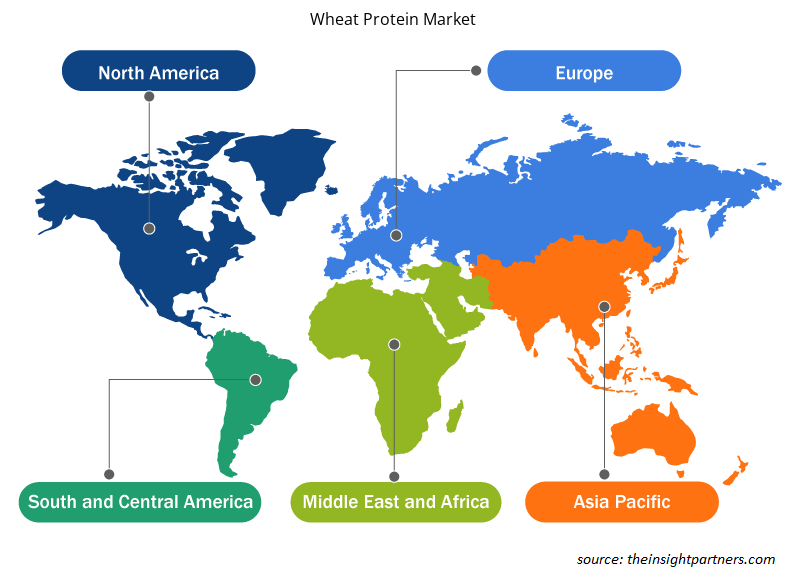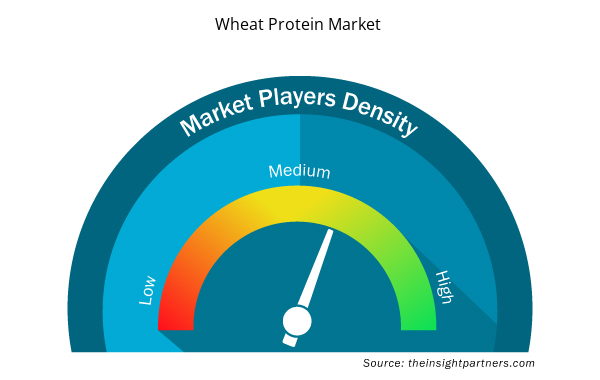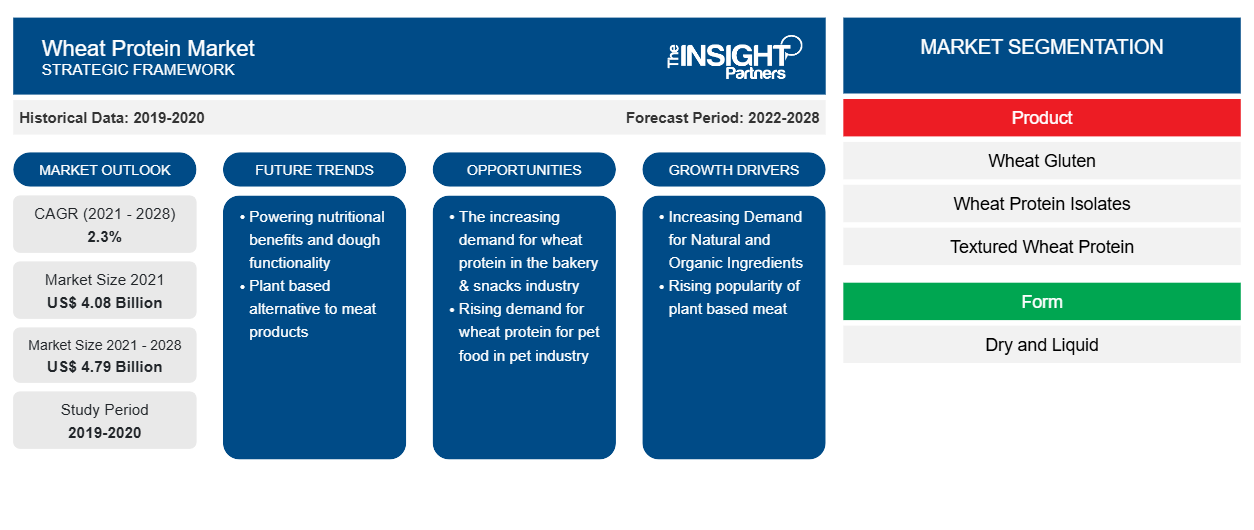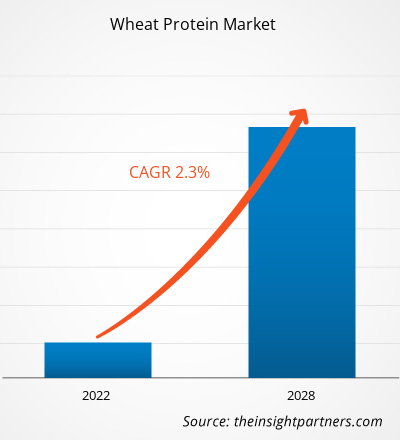[Informe de investigación] El mercado de proteína de trigo se valoró en US$ 4.083,05 millones en 2021 y se proyecta que alcance los US$ 4.788,49 millones en 2028; se espera que crezca a una CAGR del 2,3% de 2021 a 2028.
Las proteínas de trigo son proteínas de origen vegetal que se obtienen principalmente mediante el procesamiento del trigo con diferentes enzimas. Son proteínas funcionales insolubles que poseen características viscoelásticas únicas y ofrecen elasticidad y extensibilidad a un producto final. Las proteínas se consideran una alternativa viable a las proteínas de origen animal. Se utilizan ampliamente en varias industrias de uso final, como panaderías y confitería , cosméticos y cuidado personal, alimentos para animales y suplementos nutricionales.
En 2020, Europa tuvo la mayor participación en los ingresos del mercado mundial de proteína de trigo . El mercado europeo está segmentado en Alemania, Francia, Italia, el Reino Unido, Rusia y el resto de Europa. La creciente conciencia de la salud entre los consumidores impulsa la demanda de numerosos productos de proteína vegetal, como la soja, el trigo y la avena . La popularidad de la proteína de trigo ha aumentado en toda la región, particularmente en Alemania, Francia y el Reino Unido. Los europeos están adoptando cada vez más la dieta flexitariana, es decir, reemplazando parte o la mayor parte de su consumo de carne con alimentos proteicos alternativos. Estos factores impulsan la demanda de productos de proteína de trigo en Europa.
Personalice este informe según sus necesidades
Obtendrá personalización en cualquier informe, sin cargo, incluidas partes de este informe o análisis a nivel de país, paquete de datos de Excel, así como también grandes ofertas y descuentos para empresas emergentes y universidades.
- Obtenga las principales tendencias clave del mercado de este informe.Esta muestra GRATUITA incluirá análisis de datos, desde tendencias del mercado hasta estimaciones y pronósticos.
Muchas industrias, como la de alimentos y bebidas, se enfrentaron a desafíos sin precedentes debido a la pandemia de COVID-19. Debido a la escasez en el suministro de materias primas, el cierre de fábricas, la escasez de mano de obra y otras dificultades en las operaciones bajo los protocolos de seguridad de COVID-19, las empresas involucradas en la fabricación de proteína de trigo enfrentaron dificultades durante los meses iniciales de la pandemia. El sector de alimentos y bebidas es el mayor consumidor de proteína de trigo y la pandemia de COVID-19 en curso ha influido negativamente en la demanda de proteína de trigo. Los productos alimenticios y bebidas, como productos de panadería, artículos de confitería y productos lácteos, están siendo retrasados a medida que los supermercados han reasignado las prioridades de existencias hacia productos básicos y suministros esenciales debido al brote. Sin embargo, a medida que las economías reactivan sus operaciones, se anticipa que la demanda de proteína de trigo aumentará en todo el mundo en los próximos meses. La pandemia de COVID-19 ha provocado una mayor demanda de productos de panadería saludables y funcionales, lo que se espera que impulse el crecimiento del mercado de proteína de trigo en los próximos años.
Perspectivas del mercado
Demanda creciente de ingredientes naturales y orgánicos
La importancia de los alimentos orgánicos se ha comprendido a raíz de los alarmantes problemas de salud, junto con la creciente conciencia sobre las certificaciones orgánicas y la creciente preferencia por alimentos de alta calidad. Hoy en día, los consumidores buscan ingredientes naturales, limpios y simples con etiquetas adecuadas, que puedan transmitir de manera efectiva su contenido, calidad e intención de uso del producto. Además, dependen en gran medida de productos alimenticios orgánicos y naturales. Por ejemplo, el consumo de proteína de trigo orgánica ha aumentado considerablemente en diversos sectores de aplicación, como alimentos y bebidas, y alimentos para animales y acuicultura. Por lo tanto, los fabricantes de proteína de trigo se están centrando en el desarrollo y la comercialización de proteína de trigo orgánica.
Información sobre el producto
Según el producto, el mercado mundial de proteína de trigo se segmenta en gluten de trigo, aislados de proteína de trigo, proteína de trigo texturizada y proteína de trigo hidrolizada. En 2020, el segmento de gluten de trigo representó la mayor participación en los ingresos. El gluten de trigo vital se utiliza como aditivo en la panadería. Agrega elasticidad a las harinas, que de otro modo serían bajas en gluten, como la harina integral o la de centeno. El gluten de trigo también mejora el crecimiento de la masa cruda y mejora la textura y la masticabilidad del producto final.
Información sobre formularios
El mercado de la proteína de trigo, por su forma, se bifurca en seco y líquido. En 2020, el segmento seco representó una mayor participación en los ingresos. Algunas de las propiedades de la proteína de trigo seca son alta solubilidad en agua con cualquier valor de pH, capacidad de unión y emulsión de agua, baja viscosidad y estabilidad ácida y térmica. La proteína de trigo seca se utiliza cada vez más en panaderías, alimentos para mascotas, barras nutricionales, carne procesada y análogos de carne. Por lo tanto, las amplias aplicaciones en la industria alimentaria están impulsando el crecimiento del mercado del segmento seco.
Información sobre aplicaciones
El mercado de proteínas de trigo, por aplicación, se segmenta en panadería y snacks, alimentos para mascotas, barras y bebidas nutricionales, carne procesada, análogos de carne y otros. En 2020, el segmento de panadería y snacks representó la mayor participación en los ingresos. Numerosos productos de panadería, como panecillos, pan, galletas, pasteles, tartas y muffins, son populares entre los consumidores. Las proteínas de trigo se encuentran entre los ingredientes comunes que optimizan el comportamiento de la masa y mejoran las propiedades nutricionales de los productos finales. La creciente demanda de proteína de trigo en la industria de panadería y snacks y la tendencia de la etiqueta limpia están creando amplias oportunidades para los actores que operan en el mercado de proteína de trigo en todo el mundo.
Archer Daniels Midland Company; Roquette Frères; Glico Nutrition Co., Ltd; Kröner-Stärke GmbH; Cargill, Incorporated; Crespel & Deiters GmbH & Co. KG; CropEnergies AG; Manildra Group; MGP Ingredients Inc.; y Tereos Group son algunos de los actores bien establecidos en el mercado global de proteína de trigo. Las empresas del mercado están adoptando diversas estrategias, como desarrollos de productos, expansiones de plantas y fusiones y adquisiciones, para expandir su presencia en todo el mundo y satisfacer la creciente demanda de los usuarios finales. Por ejemplo, en 2020, Archer Daniels Midland Company desarrolló nuevos productos. Los productos contienen proteínas de guisante texturizadas Arcon T, proteína de trigo texturizada Prolite MeatTEX y proteína de trigo no texturizada Prolite MeatXT.
Informe Destacado
- Tendencias progresivas de la industria en el mercado mundial de proteína de trigo para ayudar a los actores a desarrollar estrategias efectivas a largo plazo
- Estrategias de crecimiento empresarial adoptadas por los mercados desarrollados y en desarrollo
- Análisis cuantitativo del mercado mundial de proteína de trigo de 2019 a 2028
- Estimación de la demanda de proteína de trigo en diversas industrias
- Desarrollos recientes para comprender el escenario competitivo del mercado y la demanda de proteína de trigo
- Tendencias y perspectivas del mercado junto con los factores que impulsan y restringen el crecimiento del mercado de proteína de trigo
- Proceso de toma de decisiones mediante la comprensión de las estrategias que sustentan el interés comercial con respecto al crecimiento del mercado mundial de proteína de trigo
- Tamaño del mercado de proteína de trigo en varios nodos del mercado
- Descripción detallada y segmentación del mercado mundial de proteína de trigo, así como su dinámica en la industria.
- Tamaño del mercado de proteína de trigo en varias regiones con oportunidades de crecimiento prometedoras
Perspectivas regionales del mercado de proteína de trigo
Los analistas de Insight Partners explicaron en detalle las tendencias y los factores regionales que influyen en el mercado de proteína de trigo durante el período de pronóstico. Esta sección también analiza los segmentos y la geografía del mercado de proteína de trigo en América del Norte, Europa, Asia Pacífico, Oriente Medio y África, y América del Sur y Central.

- Obtenga datos regionales específicos para el mercado de proteína de trigo
Alcance del informe sobre el mercado de proteína de trigo
| Atributo del informe | Detalles |
|---|---|
| Tamaño del mercado en 2021 | US$ 4.08 mil millones |
| Tamaño del mercado en 2028 | 4.790 millones de dólares estadounidenses |
| CAGR global (2021-2028) | 2,3% |
| Datos históricos | 2019-2020 |
| Período de pronóstico | 2022-2028 |
| Segmentos cubiertos | Por producto
|
| Regiones y países cubiertos | América del norte
|
| Líderes del mercado y perfiles de empresas clave |
|
Densidad de los actores del mercado de proteínas de trigo: comprensión de su impacto en la dinámica empresarial
El mercado de proteína de trigo está creciendo rápidamente, impulsado por la creciente demanda de los usuarios finales debido a factores como la evolución de las preferencias de los consumidores, los avances tecnológicos y una mayor conciencia de los beneficios del producto. A medida que aumenta la demanda, las empresas amplían sus ofertas, innovan para satisfacer las necesidades de los consumidores y aprovechan las tendencias emergentes, lo que impulsa aún más el crecimiento del mercado.
La densidad de actores del mercado se refiere a la distribución de las empresas o firmas que operan dentro de un mercado o industria en particular. Indica cuántos competidores (actores del mercado) están presentes en un espacio de mercado determinado en relación con su tamaño o valor total de mercado.
Las principales empresas que operan en el mercado de proteína de trigo son:
- Compañía Midland de Archer Daniels
- Hermanos Roquette
- Glico Nutrition Co., Ltd.
- Kröner-Stärke GmbH
- Cargill, Incorporada
Descargo de responsabilidad : Las empresas enumeradas anteriormente no están clasificadas en ningún orden particular.

- Obtenga una descripción general de los principales actores clave del mercado de proteína de trigo
Mercado de proteína de trigo, por
- Producto
- Gluten de trigo
- Aislados de proteína de trigo
- Proteína de trigo texturizada
- Proteína de trigo hidrolizada
Mercado de proteína de trigo, por forma
- Seco
- Líquido
Mercado de proteína de trigo, por aplicación
- Panadería y Snacks
- Comida para mascotas
- Barras y bebidas nutritivas
- Carne procesada
- Análogos de la carne
- Otros
Perfiles de empresas
- Compañía Midland de Archer Daniels
- Hermanos Roquette
- Glico Nutrition Co., Ltd.
- Kröner-Stärke GmbH
- Cargill, Incorporada
- Crespel & Deiters GmbH & Co. KG
- CropEnergies AG
- Grupo Manildra
- Ingredientes MGP Inc.
- Grupo Tereos
- Análisis histórico (2 años), año base, pronóstico (7 años) con CAGR
- Análisis PEST y FODA
- Tamaño del mercado Valor/volumen: global, regional, nacional
- Industria y panorama competitivo
- Conjunto de datos de Excel



Report Coverage
Revenue forecast, Company Analysis, Industry landscape, Growth factors, and Trends

Segment Covered
This text is related
to segments covered.

Regional Scope
North America, Europe, Asia Pacific, Middle East & Africa, South & Central America

Country Scope
This text is related
to country scope.
Preguntas frecuentes
Rising application of wheat protein in several end-user industries is one of the key factors for the growth of the global wheat protein market. The change in consumer preference toward ready-to-eat foodstuffs has augmented the demand for bakery products, thereby influencing the growth of the wheat protein market. Further, increasing demand for premium pet food products from developing and developed countries, growing demand for natural and organic ingredients, and rising demand for meat analogs are the other factors driving the wheat protein market.
During the forecast period, Europe is anticipated to account for the largest share of the global wheat protein market. With rising health awareness among consumers, the demand for plant protein products, including soy, wheat, oat, and others, is expected to continue growing during the projected period. The popularity of the wheat protein has increased within the region, particularly in Germany, France, and the UK. Europeans are increasingly adopting the flexitarian diet, i.e., replacing part or most of their meat consumption with alternative protein food. Also, government support is driving the growth of this market.
The major players operating in the global wheat protein market are Archer Daniels Midland Company; Roquette Frères; Glico Nutrition Co.,Ltd; Kröner-Stärke GmbH; Cargill, Incorporated; Crespel & Deiters GmbH & Co. KG; Croproteinses AG; Manildra Group; MGP Ingredients Inc.; and Tereos Group
On the basis of product, the textured wheat protein segment led the global wheat protein market in 2020. Textured wheat protein products have broader applications, as a protein enrichment in baked goods, as a meat extension in meat products, for goulash, pulled products, for toppings, for a firm bite in burgers and fillings, as a meat extension in nuggets, and meat emulsions & raw sausages. Due to the wider application of textured wheat protein products, the market for wheat protein is blooming at a rapid pace.
Based on application, bakery & snacks segment accounted for the largest share in the global wheat protein market in 2020. The growth is attributed to rapidly evolving consumer preferences, greater demand for indulgence foods, increasing health consciousness among consumers. Wheat protein is a crucial source of high-protein, low-carb, and high-fibre, essential for producing bakery & snack products.
Based on form, the dry segment accounted for the largest share in the global wheat protein market. Dry wheat proteins are made from vital wheat gluten and are soluble in water. The dry wheat protein is increasingly used in bakeries, pet food, nutritional bars, processed meat, and meat analogs. Thus, the wide applications in the food industry are bolstering the dry segment growth.
Trends and growth analysis reports related to Food and Beverages : READ MORE..
The List of Companies - Wheat Protein Market
- Archer Daniels Midland Company
- Roquette Frères
- Glico Nutrition Co.,Ltd
- Kröner-Stärke GmbH
- Cargill, Incorporated
- Crespel & Deiters GmbH & Co. KG
- CropEnergies AG
- Manildra Group
- MGP Ingredients Inc.
- Tereos Group
The Insight Partners performs research in 4 major stages: Data Collection & Secondary Research, Primary Research, Data Analysis and Data Triangulation & Final Review.
- Data Collection and Secondary Research:
As a market research and consulting firm operating from a decade, we have published and advised several client across the globe. First step for any study will start with an assessment of currently available data and insights from existing reports. Further, historical and current market information is collected from Investor Presentations, Annual Reports, SEC Filings, etc., and other information related to company’s performance and market positioning are gathered from Paid Databases (Factiva, Hoovers, and Reuters) and various other publications available in public domain.
Several associations trade associates, technical forums, institutes, societies and organization are accessed to gain technical as well as market related insights through their publications such as research papers, blogs and press releases related to the studies are referred to get cues about the market. Further, white papers, journals, magazines, and other news articles published in last 3 years are scrutinized and analyzed to understand the current market trends.
- Primary Research:
The primarily interview analysis comprise of data obtained from industry participants interview and answers to survey questions gathered by in-house primary team.
For primary research, interviews are conducted with industry experts/CEOs/Marketing Managers/VPs/Subject Matter Experts from both demand and supply side to get a 360-degree view of the market. The primary team conducts several interviews based on the complexity of the markets to understand the various market trends and dynamics which makes research more credible and precise.
A typical research interview fulfils the following functions:
- Provides first-hand information on the market size, market trends, growth trends, competitive landscape, and outlook
- Validates and strengthens in-house secondary research findings
- Develops the analysis team’s expertise and market understanding
Primary research involves email interactions and telephone interviews for each market, category, segment, and sub-segment across geographies. The participants who typically take part in such a process include, but are not limited to:
- Industry participants: VPs, business development managers, market intelligence managers and national sales managers
- Outside experts: Valuation experts, research analysts and key opinion leaders specializing in the electronics and semiconductor industry.
Below is the breakup of our primary respondents by company, designation, and region:

Once we receive the confirmation from primary research sources or primary respondents, we finalize the base year market estimation and forecast the data as per the macroeconomic and microeconomic factors assessed during data collection.
- Data Analysis:
Once data is validated through both secondary as well as primary respondents, we finalize the market estimations by hypothesis formulation and factor analysis at regional and country level.
- Macro-Economic Factor Analysis:
We analyse macroeconomic indicators such the gross domestic product (GDP), increase in the demand for goods and services across industries, technological advancement, regional economic growth, governmental policies, the influence of COVID-19, PEST analysis, and other aspects. This analysis aids in setting benchmarks for various nations/regions and approximating market splits. Additionally, the general trend of the aforementioned components aid in determining the market's development possibilities.
- Country Level Data:
Various factors that are especially aligned to the country are taken into account to determine the market size for a certain area and country, including the presence of vendors, such as headquarters and offices, the country's GDP, demand patterns, and industry growth. To comprehend the market dynamics for the nation, a number of growth variables, inhibitors, application areas, and current market trends are researched. The aforementioned elements aid in determining the country's overall market's growth potential.
- Company Profile:
The “Table of Contents” is formulated by listing and analyzing more than 25 - 30 companies operating in the market ecosystem across geographies. However, we profile only 10 companies as a standard practice in our syndicate reports. These 10 companies comprise leading, emerging, and regional players. Nonetheless, our analysis is not restricted to the 10 listed companies, we also analyze other companies present in the market to develop a holistic view and understand the prevailing trends. The “Company Profiles” section in the report covers key facts, business description, products & services, financial information, SWOT analysis, and key developments. The financial information presented is extracted from the annual reports and official documents of the publicly listed companies. Upon collecting the information for the sections of respective companies, we verify them via various primary sources and then compile the data in respective company profiles. The company level information helps us in deriving the base number as well as in forecasting the market size.
- Developing Base Number:
Aggregation of sales statistics (2020-2022) and macro-economic factor, and other secondary and primary research insights are utilized to arrive at base number and related market shares for 2022. The data gaps are identified in this step and relevant market data is analyzed, collected from paid primary interviews or databases. On finalizing the base year market size, forecasts are developed on the basis of macro-economic, industry and market growth factors and company level analysis.
- Data Triangulation and Final Review:
The market findings and base year market size calculations are validated from supply as well as demand side. Demand side validations are based on macro-economic factor analysis and benchmarks for respective regions and countries. In case of supply side validations, revenues of major companies are estimated (in case not available) based on industry benchmark, approximate number of employees, product portfolio, and primary interviews revenues are gathered. Further revenue from target product/service segment is assessed to avoid overshooting of market statistics. In case of heavy deviations between supply and demand side values, all thes steps are repeated to achieve synchronization.
We follow an iterative model, wherein we share our research findings with Subject Matter Experts (SME’s) and Key Opinion Leaders (KOLs) until consensus view of the market is not formulated – this model negates any drastic deviation in the opinions of experts. Only validated and universally acceptable research findings are quoted in our reports.
We have important check points that we use to validate our research findings – which we call – data triangulation, where we validate the information, we generate from secondary sources with primary interviews and then we re-validate with our internal data bases and Subject matter experts. This comprehensive model enables us to deliver high quality, reliable data in shortest possible time.


 Obtenga una muestra gratuita de este informe
Obtenga una muestra gratuita de este informe